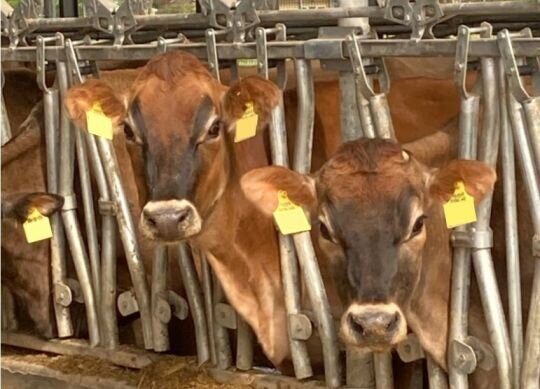Heat Stress – What’s the Hype?
Heat stress costs the dairy industry over $897 million annually in losses attributed to decreased performance, increased mortality, and decreased reproduction (St. Pierre et al., 2003). It is caused by a number of factors, including air temperature, humidity, wind speed, and solar radiation. Cattle experience heat stress when they cannot physically cope with their environmental conditions. Producers know heat stress can have severe impacts on cattle, but what exactly happens to a cow experiencing heat stress?
While the impact of heat on an animal may seem rapid, heat stress occurs in progressive steps, from mild to extreme.
Mild
Visible discomfort and reduction in activity. This is one of the first signs of heat stress. When temperatures and humidity rise, cattle that are experiencing mild stress typically will seek out shade or the coolest place they can find. Like humans, cattle will also experience increased sweating when experiencing mild heat stress.
Moderate
Decreased feed intake & increased water consumption. Animals under moderate heat stress will often provide a visual cue by crowding the water supply. Another visual identifier is panting. Cattle pant to increase their respiration rate. They exhibit this behavior when evaporative heat (sweating) is not enough to cool them down. A fourth sign of moderate heat stress is increased heart rate. The heart rate increases to pump more blood towards the skin to help cool the animal.
Severe
Protruding tongue. When cattle are experiencing severe heat stress, panting, and sweating are not enough to cool them off. During a severe heat stress event, cattle will stick their tongue out in an attempt to cool off. The protruding tongue can lead to excessive drooling, thereby reducing the amount of saliva reaching the rumen. This reduction in saliva can create an increased risk of ruminal acidosis.
Another impact of severe heat stress takes place at the cellular level in the intestines. Severe heat stress reduces the amount of blood flow to the intestinal walls because most of the blood is being pumped toward the skin in an effort to cool the animal. This reduced blood flow creates a potentially dangerous situation as the cells become dehydrated, breaking down the intestinal barrier and allowing pathogens to enter the blood stream. Damage to the intestinal barrier combined with oxidative stress can lead to a condition called leaky gut.
Extreme
At this level of heat stress, affected cows are unable to physically respond to the stress on their bodies. Extreme heat stress can lead to death.
If the animal survives an extreme heat stress event, it will likely take more time to recover and return to typical production levels. Death from extreme heat stress is most often a result of the animal’s heart not being able to keep up the high rate of pumping required to eliminate the heat, leading to heart failure. Should the animal survive an extreme heat event, but dies days later, it is generally from the effects of pathogens in the blood stream from damaged intestinal barriers.
Animals should never reach the level of extreme heat stress. Best management practices and proper animal husbandry should be in place to prevent this from occurring.
Heat stress affects animals at every stage of lactation. When animals undergo heat stress during the dry period it can have lasting effects on their entire lactation. To learn more about heat stress and heat stress during the dry period click HERE for a webinar describing these effects.



